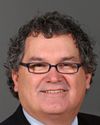Thank you.
To my left is Marc Lanteigne, who is the manager of the aquatic resources division in the gulf region. To my right is Sylvain Paradis, who is the director general of ecosystems sciences.
This afternoon I will speak very briefly about snow crab management. I believe you've been provided with a deck that has a much more detailed description of the biology of the snow crab, a description of some of the management processes we're using, and an overview of the economics of the fishery.
The most distinctive element about this fishery is its cyclical nature. Since DFO began annual surveys in 1988, we have seen two periods of abundance followed by declines, and then a rebound to productive stocks. Science has determined that this is simply a part of the natural cycle of this species and has little to do with fishing activity, but its amplitude could be influenced by the intensity of fishing, particularly the harvest rate.
What this means in terms of management is that quotas need to be adjusted to parallel the natural fluctuations in biomass. When stocks are low, it is especially important to adopt a precautionary approach to enable the normal rebuilding cycle to commence.
Management decisions and quota levels are guided by the best available scientific assessment and advice. That science has proven to be very accurate over the last couple of cycles. We have good predictions provided to us by science that we can respond to. In conjunction with science, consultations are held by industry on management measures and total allowable catches. It's the role of science to assess risks and to provide information to managers and to decision-makers, and those decisions are taken in consultation with those people who will be directly affected by them. In the past, stakeholders have been willing to accept higher levels of risk, resulting in limited reductions in quota, with the understanding that in the future, at low parts of the cycle, difficult decisions would be required.
We are applying the precautionary approach to this fishery. That's the method we are using for many of the key fisheries in Canada, and we intend to continue to develop a precautionary approach for our management of Canadians' natural resources.
A fishery that follows this precautionary approach demonstrates a management strategy that is based on sustainability, thereby fulfilling eco-certification guidelines and providing a fishery with a competitive market advantage. We now have a clearer picture from other years of where the fishery sits in relation to biological reference points, which are the key indicators that determine whether the stock is in healthy, cautious, or critical zones. It is clear that the estimated biomass for the 2010 fishery has decreased compared to 2009 and is now in the cautious zone. We have the benefit in this stock of going through very healthy times, but when the stock is in the lower part of the cycle, we must ensure we take a cautious approach to avoid going into the critical zone.
The science peer review conducted in February 2010 confirmed a 46% decline in biomass for the southern Gulf of St. Lawrence from the previous year's level. It also indicated that recruitment to the fisheries is expected to remain low in 2011. That can be determined by the trawl survey results. If juveniles about to enter the fishery are not present in large numbers, we know that the recruitment for next year, for example, will be low. However, we would expect the recruitment to pick up from 2012 onward.
Therefore, using the reference points, it was important to establish more stringent management measures to protect the reproductive portion of the stock, reduce the risk of falling into the critical zone in the following years, and avoid extending the current period of low biomass. This conservation concern was a primary driver that led to the decision to set the TAC or quota at 7,700 tonnes for area 12. That quota provides the best balance between providing some economic benefit to stakeholders and helping to ensure that the stock is able to rebuild.
We know how this lowered quota has affected the harvesters and plant workers in provinces such as New Brunswick and Quebec. However, the federal government has provided funding to the provinces for such adjustments in all industries, and hopefully they would use some of that to assist the onshore processing sectors.
In past years, the willingness for harvesters to accept a higher risk when setting quotas has equated to an average gross revenue of $500,000 per licence holder. That would be in the traditional fleets and not the inshore fleets. Now that we are situated at the bottom of the natural abundance cycle, harvesters must concede to conservation concerns and accept the consequences, recognizing that this is not a permanent long-term situation. The stock is expected to rebound if adequate measures, such as the ones implemented this year, are taken to allow the stock to grow from its current lower level.
In order for crab harvesters to reduce operating costs and maximize their efficiency, the department has introduced flexibilities around quota transfers between enterprises and partnering operations that will allow harvesters to make business decisions and arrangements based on their individual needs. Approximately 22% of licence holders have taken advantage of the quota transfer option, and several new partnerships have been formed. Those all allow much lower costs for the harvesters.
I'll stop there, Mr. Chairman. I note that many are interested in the deck we provided. If there are any questions, I or my colleagues would be glad to respond to them.










